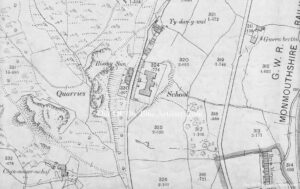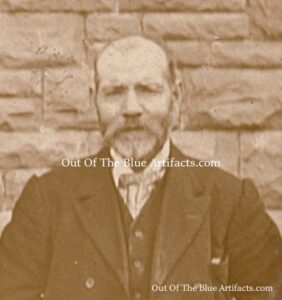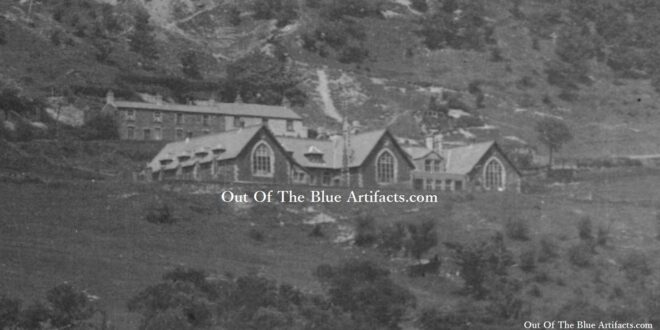The Board Schools Cwmtillery – Cwmtillery Junior Mixed (Cock n Chick School).
The Board Schools Cwmtillery – Cwmtillery Mixed School (Cock n Chick School) was situated on the eastern side of Mynydd James (Cock n Chick Mountain) on the western side of the Cwmtillery valley, overlooking Penybont. The school was known and referred to by many names in old reports, the Board Schools, the Mixed School, the Junior Mixed School and locally known as the Cock n Chick.
 The School Proposal.
The School Proposal.
On Thursday 14th of May 1874, the educational department gave notice to the Aberystruth School Board that it required educational accommodation for 400 boys and girls and 200 infants in the district.
The Building of the School.
The South Wales Colliery Company, who owned the Cwmtillery Colliery and area along with their new Rose Heyworth Colliery, sold the department a piece of land on the western side of the valley between Cwmtillery and Blaenau Gwent for a nominal sum of £50 and the building of the school went ahead at an estimated cost of £3,000.
The Contractor and Architect.
The contractors were the Foster Bros of Abergavenny. The architect was Mr W. D. Blessley of Cardiff.
The Official Opening.
On Monday 15th of January 1877, the Board Schools, Cwmtillery were officially opened.
The Opening Ceremony.
Guest at the opening ceremony were – Mr Lawrence Heyworth for the South Wales Colliery Co; Mr J. W. Walters J.P.; The Rev Howell Howells; Mr T. Phillips; Mr J. Thomas of Brynmawr and Dr Soper; Mr Edmund Morgan; Mr Titus Phillips (Vice Chairman of the Board); Mr J. Harding; Mr W. Dayson; Rev J. A. Jones (Clerk); Mr Walters (Treasurer); Dr Williams; Rev J. Lewis and Mr Allen (Nantyglo):
Mr Lawrence Heyworth.
Mr Lawrence Heyworth spoke on behalf of the company and said, “The company, the South Wales Colliery Co, wanted to venture out into building schools in the area but the costs put them off, though they still had the welfare of the valley foremost in their minds”. Mr J. W. Walters spoke and said, “As a means of encouraging regular attendance of children at the school he would offer 5 guineas to be given out as prizes for those boys and girls who attended with the greatest regularity”.
The Rev Howell Howells spoke to contradict a notion that the church was against these schools and said he welcomed it, although hoped that the board would not build more than was needed.
Mr T. Phillips of Abertillery praised the South Wales Colliery Company for the generosity in only charging £50 for the whole site when the prices were quoted at £1,000 per acre from other companies at the time. Mr J. Thomas and Dr Soper responded and following a speech from Col Heyworth the party dispersed to view the schools.
The party then left and walked to the Clyn Mawr Hotel for lunch where Mr Edmund Morgan took the chair. Toasts were given to the South Wales Colliery Co, the people of the valley, the coal iron and general trade of the district, the Aberystruth School Board and the Guardians of the Bedwelty Union.
Description of the Building.
A descriptive account of the building – The style of the building was Gothic, they were faced with local stone and erected in snail creepwork, with Bath stone dressings. The schoolrooms were well constructed and there was an extensive playground. The back retaining wall was a considerable height and held back with a series of four large buttresses. Situated on a breezy height on the Abertillery Road between Cwmtillery and Blaenau Gwent the schools presented a picturesque appearance.
The final cost of the scheme was £3,600 which included the contract (£3,250). Extras (£50). The architects commission and legal expenses (£250) and the cost of the site. The amount was borrowed from the Public Works Loan Commissioners and was repayable in 50 equal annual instalments of £170 per annum.
The school was built from local stone, this stone was from the quarry situated behind the school which was originally opened in 1874 for the stone with which the South Wales Colliery Co used to build the Blaenau Gwent Rows, under the direction of Capt. Lawrence Heyworth.
Mr Edward Jones, Miss Ramsey and Miss Russell.
In 1877 Mr Edward Jones became the first headmaster. Miss Ramsey was the girls’ mistress and Miss Russell was the infants’ mistress.
Mr Edward Jones and Miss Ramsey.
In the 1880 Slaters Directory Mr Edward Jones was the headmaster and Miss Ramsey was the girls’ mistress.
Mr Edmund James Williams.
In 1882 Mr Edmund James Williams was appointed headmaster upon the departure of Mr Edward Jones who had left to be the headmaster at the Blaina Boys School.
Mr Edmund James Williams, Miss A. E. Carpenter and Miss A. A. Stanfield.
In the 1891 Kelly’s Directory Mr Edmund James Williams was headmaster, Miss A. E. Carpenter was the girls’ mistress and Miss A. A. Stanfield was the infants’ mistress.
The Departure of Mr Edmund James Williams.
In 1899 Mr Edmund James Williams became the headmaster at Queen Street School, he was only there for a short while and retired in 1900 to become the landlord of the Bell Inn, Abertillery.
Mr John Jones, Miss A. Davies and Miss Lizzie Gilligan.
In the 1901 Kelly’s Directory Mr John Jones was headmaster, Miss A. Davies was girls’ mistress and Miss Lizzie Gilligan was the infants’ mistress.
The Cock n Chick Name.
Some point in time the Cwmtillery Board School picked up the nickname Cock n Chick, the reasoning behind this is unclear, although I believe it was because of the school being a mixed school, girls and boys i.e., cock n chick. The mountain and area also become known as such.
The Buttresses.
The Cwmtillery Cock n Chick School, (as seen in the main featured image above) was constructed at a high elevation on the side of the mountain, its rear wall was about 22′ feet in height that was in close proximity to the actual school building. This retaining wall had a series of wide buttresses along its length giving the wall extra strength. These buttresses were very often climbed by the pupils, which was an offence at the time, anyone who were caught climbing them were severely dealt with.
Master Ivor Cecil.
On Tuesday 10th of December 1912, one of the first deaths was recorded in connection with the buttresses at the Cwmtillery Cock n Chick School. Master Ivor Cecil of Winifred Terrace, Cwmtillery died after falling from a height of 22′ feet into the playground from one of the buttresses.
Mr Giraldus G. Gunter and Miss Elizabeth Mary Badger.
In the 1914 Kelly’s Directory Mr Giraldus G. Gunter was the headmaster and Miss Elizabeth Mary Badger was the girls’ mistress.
Mr Giraldus G. Gunter and Miss Elizabeth Mary Badger.
In the 1920 Kelly’s Directory Mr Giraldus G. Gunter was the headmaster and Miss Elizabeth Mary Badger was the girls’ mistress.
Mr George Harris.
In 1931 Mr George Harris was the headmaster at the school, there was no information on the girls or infants’ mistresses.
The Air-Raid Shelters.
Prior the second world war, air-raid shelters were erected in the grounds of the school, red brick buildings with solid concrete roofs.
The Dinner Hall and Canteen.
A corrugated shed was also built along the front of the school playground to house the canteen and dining areas.
Mr T. Thomas.
In the late 1930’s Mr T. Thomas was the headmaster.
Mr C. O. Coldicott.
In 1940 Mr Clifford Owen Coldicott became headmaster. Mr Coldicott was the headmaster at Cwmtillery until 1942 when was transferred to Queen Street School. There was no information on the girls or infants’ mistresses.
Mr Jack Thomas.
Sometime after the second world war Mr Jack Thomas became the headmaster, there was no information on the girls or infants’ mistresses. Upon Mr Thomas’s retirement in 1963 it was reported that he had been on the teaching staff at the Cwmtillery School, Cock n Chick for 45 years.
Mr John Gomery.
In 1968 Mr John Gomery was the headmaster at the Cwmtillery School, Cock n Chick.
(More information to come).
The Later Years.
The Cwmtillery Junior Mixed School, Cock n Chick closed in the latter half of the 1990’s and the children, along with the pupils from the Crown Infants School were transferred to the new Millennium School at Rose Heyworth. The school building was later demolished with private houses being built upon the site.
 Points of Interest – Mr John Davies 1844 – 1923.
Points of Interest – Mr John Davies 1844 – 1923.
Worth mentioning is Mr John Davies of 28 Victoria Street, Blaenau Gwent, one of the most well-known inhabitants in the area. Mr Davies (as seen left) was the eldest son of Mr Joshua Davies, a tailor from Blaenau Gwent. As a young man he worked underground and later became a colliery overman at the Cwmtillery Collieries.
On Saturday 18th of January 1868, he married Miss Anna Crowder from Newport. He later became a contractor under the South Wales Colliery Company, in his capacity as a contractor he excavated the ground for the Cwmtillery Board School, Cwmtillery, to be built. Afterwards he went to work at the Rose Heyworth Colliery.
In 1904 he became the areas school’s attendance officer, was also a member of the first Technical Instruction Committee. In later life he was the senior deacon of Blaenau Gwent Baptist Church and was also the president of the Abertillery Sunday School Union.
At his time of death in 1923 his wife Anna and his four children survived him – His children – Mr John W. Davies who worked as an official under the Ebbw Vale Co; Mr Fred M. Davies; Mr T. H. Davies an overman at the Rose Heyworth Colliery and Miss Esther Jane Davies a teacher at the Blaenau Gwent Infants School:
Mr Edmund James Williams.
Mr Edmund James Williams the headmaster at the school (1882 – 1899) was born in 1855 at Abertillery. The eldest son of Mr Joseph Williams of Llanelly, Breconshire. Mr Edmund James Williams was the grandson of “Squire James” Mr Edmund James, freehold landowner and timber merchant of Abertillery whose land was purchased by Messrs Webbs, Aberbeeg. Mr E. J. Williams was educated at the British School under Mr Thomas Bevan and attended further education at Swansea and Bangor. In 1882 he married Miss Mary A. Williams, born in 1858 at Bassaleg, Monmouthshire. Mary’s father was the landlord of the Beaufort Arms, Beaufort. In 1882 Mr Edmund James Williams went back into teaching and became the headmaster of the Cwmtillery Board School, taking over from Mr Edward Jones who had left to become the head at the Blaina Boys School. In 1899 Mr Williams took the role of headmaster at Queen Street School although after only one year in the post he resigned from the teaching profession to become licensee at the Bell Inn, Abertillery.
Mr Edmund James Williams was also a member of the Abertillery Council from 1897, being its chairman in 1903. In 1908 was chairman of the Abertillery Education Committee. A representative for Abertillery on the Western Valleys Joint Sewage Board. He was on the Board of Governors at the Abertillery County School. A member of the Abertillery and District Joint Water Board. On the Board of Governors of the University College of South Wales and Monmouth. An Overseer for the Parish of Abertillery and was on the Bedwellty Board of Guardians and he also succeeded Mr William Brace at Abertillery as representative of the North Ward. Mr Williams was a Freemason of the St Davids Lodge at Rhymney and also an Oddfellow with the Prince Howell the Good Lodge of which he was its secretary. Mr Edmund James Williams passed away in 1911.
 Out Of The Blue Artifacts A Library of a lifetime of collecting
Out Of The Blue Artifacts A Library of a lifetime of collecting
